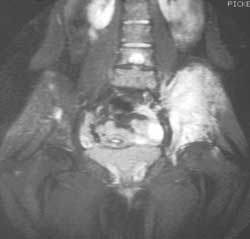New marker, new target in Ewing’s sarcoma

University of Colorado Cancer Center researchers hope that study identifying high levels of the protein EYA3 in Ewing’s sarcoma will lead to more accurate prognosis and eventually improved treatments for the disease, as seen in this MRI of a patient’s left hip. Image: cc license<br>
A University of Colorado Cancer Center study published this week in the journal Molecular Cancer Research shows an important difference that may explain why some respond and some don’t: the existence of high levels of the protein EYA3.
“First, levels of EYA3 could be a tool in offering an accurate prognosis and choosing how aggressively to treat Ewing’s Sarcoma, and second we hope that by lowering levels of EYA3, we could help increase the effectiveness of existing therapies for Ewing’s sarcoma,” says Tyler Robin, PhD, first author of the recent paper.
Researchers recently defined the role of EYA3 as a DNA repair molecule and Tyler showed that EYA3 has a similar repair role in Ewing’s sarcoma – high levels of EYA3 help the tissue survive during and recover after treatment with chemotherapy. Importantly, when Robin knocked down EYA3 in Ewing’s sarcoma cells, they became sensitized to chemotherapy.
“The genetic mutation that creates Ewing’s sarcoma also leads to high levels of EYA3,” says Heide Ford, PhD, investigator at the CU Cancer Center and associate professor in the CU School of Medicine department of ob/gyn, and the paper’s senior author.
The mutation Ford refers to and that creates Ewing’s sarcoma is the fusion of a gene from chromosome 22 to a gene in chromosome 11. Known as a EWS/FLI translocation, this mutation turns off a cell’s ability to make another, intermediate step known as miR-708 – a molecule that helps to decide what parts of the genome do and don’t get read and manufactured into proteins. In healthy tissue, miR-708 turns off the production of EYA3; in Ewing’s sarcoma, miR-708 is down and so EYA3 is up.
“Our next step is to test small molecule inhibitors against EYA3 to determine which inhibitors best sensitize Ewing’s sarcomas to chemotherapy,” says Ford.
Robin and Ford hope that recognizing EYA3 levels, reducing these levels directly, or intervening in the steps that lead to its over-production will help predict outcomes, make decisions about existing treatments, and eventually lead to new treatments for Ewing’s sarcoma.
Funding provided by National Cancer Institute ROICA095277 and F30-CA165873. This work was also supported by The Cancer League of Colorado (PN090325) from grants from the Department of Defense Breast Cancer Research Program
(W81XWH-10-1-0296) and from the Alex’s Lemonade Stand Foundation for Childhood Cancer and the Boettcher Foundation’s Webb-Waring Biomedical Research Program
Media Contact
More Information:
http://www.ucdenver.eduAll latest news from the category: Life Sciences and Chemistry
Articles and reports from the Life Sciences and chemistry area deal with applied and basic research into modern biology, chemistry and human medicine.
Valuable information can be found on a range of life sciences fields including bacteriology, biochemistry, bionics, bioinformatics, biophysics, biotechnology, genetics, geobotany, human biology, marine biology, microbiology, molecular biology, cellular biology, zoology, bioinorganic chemistry, microchemistry and environmental chemistry.
Newest articles

Silicon Carbide Innovation Alliance to drive industrial-scale semiconductor work
Known for its ability to withstand extreme environments and high voltages, silicon carbide (SiC) is a semiconducting material made up of silicon and carbon atoms arranged into crystals that is…

New SPECT/CT technique shows impressive biomarker identification
…offers increased access for prostate cancer patients. A novel SPECT/CT acquisition method can accurately detect radiopharmaceutical biodistribution in a convenient manner for prostate cancer patients, opening the door for more…

How 3D printers can give robots a soft touch
Soft skin coverings and touch sensors have emerged as a promising feature for robots that are both safer and more intuitive for human interaction, but they are expensive and difficult…





















